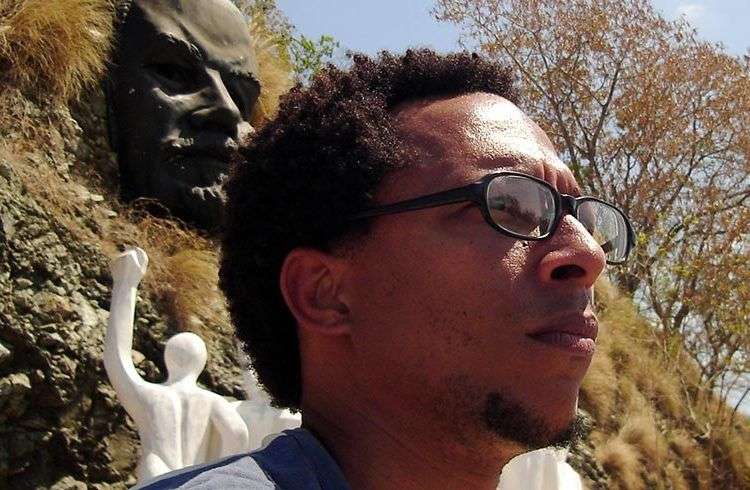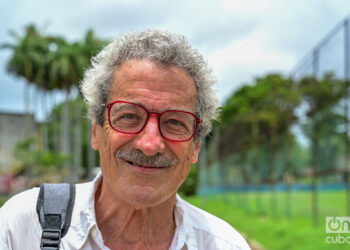Ahmel Echevarría’s (La Habana, 1974) first three books—Inventario, Esquirlas y Días de entrenamiento— makes up what he calls his Cycle of Memory. Let’s hope, for the sake of his readers, this cycle is not over yet; especially after Días de entrenamiento, a novel that hasn’t been published in Cuba (and is still non-publishable). For now, Ahmel is traveling in the past to the Quinquenio Gris / Decenio Negro, to explore foreign memories.
Jorge Fornet has also recently travelled to that same period, to his newspaper and documents. The result is entitled El 71. Anatomía de una crisis (Letras Cubanas, 2013). Essayists and researchers would radiograph a year, while narrators would make it last till present day. From their journeys Fornet brings us an anatomy and Ahmel comes back with a living and breathing body.
The body of an old writer. Here is the main character of the novel La noria (Unión, 2013), which received the Italo Calvino Award despite the strong resistance by one of the members of the jury (Leonardo Acosta, like a ghost from that year so much reviewed by Jorge Fornet, argued this story by AhmelEchevarria was harmful for the Revolution. Thus, repeating, unintentionally? A text outlined over the background of the pages he rejected, as a performance aimed at imitating fiction).
It is about an old writer who no longer writes, and after many years he attempts to retake writing. In a key passage of La noria, this character is intercepted in Obispo Street by two young men who take him for a tourist, a Cuban coming from aboard (they are not far from reality: he is a Cuban from the past). One of the young men, a self-employed tour guide with a great instinct, offers to take him to a restaurant: “It is called La Guarida… A movie was shot there… Perhaps you have heard about it. It almost got an Oscar”.
I was a teenager when I saw Fresa y Chocolate for the first time; it caught my attention that Diego had named his refrigerator. I recall I thought: part of the world of arts and literature (I disregarded the fact that he was gay, which was irrelevant for me) has to do with similar things, like naming your refrigerator. Later on, I held on to a scene where Diego pointed David to picture in the wall: “That’s Lezama, the master”.
That’s how Ahmel, ironically, refers to his main character: the master. Decades ago a commission qualified one of his books as “a real affront” (Diego was the name of one of the characters in that novel). The master ended up exhuming bodies in Cemetery of Colon. Now, he looks through the window of his apartment in Centro Habana (he has been rehabilitated, the city around him is a cemetery). Right there begins La noria. It won’t be long before the readers realize that man in the window is but a caricature.
Ahmel’s master is a man who says “thanks, darling” to the waitress pouring a glass of wine for him, and then, in front of a Remington he recalls Hemingway and Cortázar. That’s the extent of his anguish regarding influences. He also plays some music: Concerts by Brandenburg, Bola de Nieve, Elena Burke… For him, literature is something like Elena Burke. When he sits to write about some topics, his heartbeat accelerates. For some years now he has been wearing the same cologne: violets.
Is the maestro referring to some kind of Cuban writers? Is he referring to the caricature of a generation, its surroundings and common areas, its literary destination? Perhaps, but it can also be more than that. I think Ahmel collected a series of shapes, persistent shapesfloating in the air like allergens that make people and sneeze, and with that he created his main character.
Where does he come from? He comes from a photogram from Fresa y Chocolate.
Diego and David hug each other. They are happy. It all starts there and is updated there: it is the vindication of an endless number of victims, the victory of survivors. However, in that hug, which buried the New Man to set a new course, Diego and David exchanged fluids and melted in a single body. The hug of forgiveness generated a deadly feeling. That hug from more than 20 years ago brought about the master: the “substitute Lezama”, as a poem by Oscar Cruz reads (“canta bonito el desgraciado…” (the bastard knows how to sing)).A creature sometimes pathetic, sometimes ridiculous, sometimes harmless.
The other main character in La noria is the student-lover of the master, a muscular mulatoof about 50 years old named David, who is a member of the Party, like the David in the film, and (spoiler!) he seems to be with the State Security.
So, the master wants to start writing again. Something mysterious just happened to him and he wonders if he would be able to translate into words and how. The first pages of the novel portray a tired and finished writer, he is out of training facing the famous white sheet as never before, hesitating about making up “useless shapes”.
From there, the story gradually becomes a political fable, in the model of paranoid constructions. The old writer is not aware but he’s found a breach. As those stories by Philip K. Dick, an apparently minor event threatens with cracking the System, Reality. It is some sort of Truman’s Show with the master instead of Truman.
The worst about this piece by AhmelEchevarría is that it ends when it should be (getting us more anxious and thirsty for more) barely beginning. The best is that such end is completely unexpected and out of the sudden we realize there wasn’t, never was and will never be another possible ending for this character and its sad little story.
I’ll say it anyway: the master dies. I mean, he is killed.










